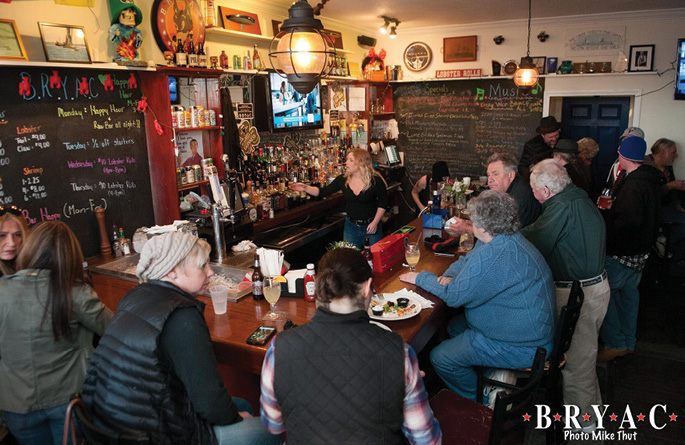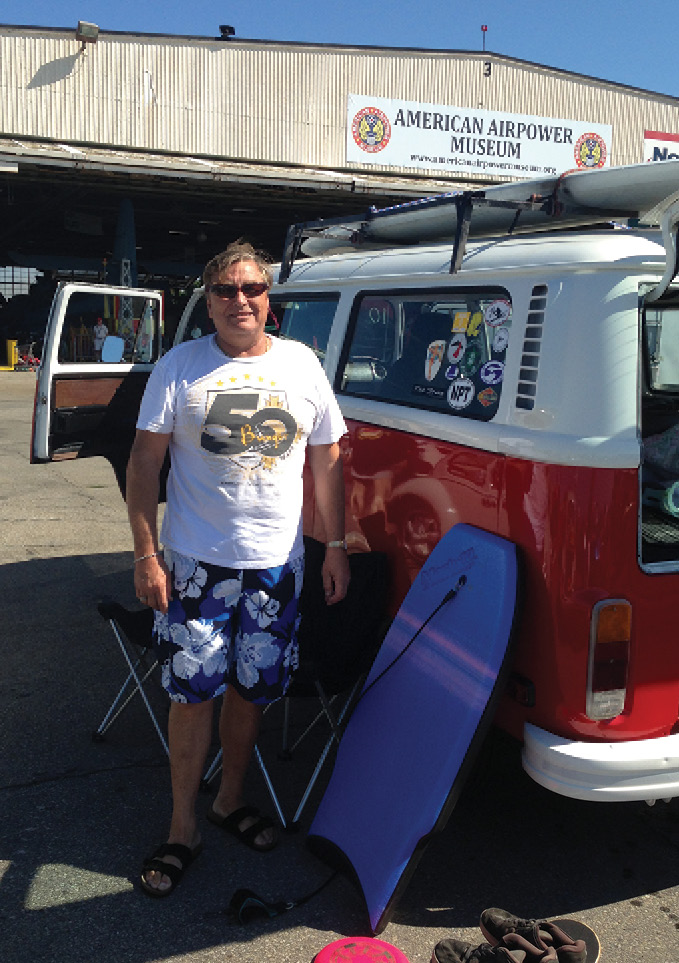By Anthony Pozun, RN
Ahoy The first in a series of four-letter words commonly exchanged by skippers as they approach one another.
Anchor Any of a number of heavy, hook-shaped devices that are dropped over the side of a vessel on the end of a rope and/or chain, and which are designed to hold said vessel securely in place until, a: the wind exceeds 2 mph, b: the owner and crew depart, or c: 3 am.
Bar A long, low-lying navigational hazard, usually awash, found at river mouths and harbor entrances, where it is composed of sand and mud; and ashore, where it’s made of mahogany or some other dark wood. Sailors can be found in large numbers around both.

Bar (n.) A long, low-lying navigational hazard, usually awash, often frequented by sailors. Relishing pre-socially distant times are the usual suspects at BRYAC Restaurant & Raw Bar in Black Rock, Connecticut.
Barometer A meteorological instrument which sailors often use to confirm the onset of bad weather. Its readings, together with heavy rain, severe rolling, high winds, dark skies, and deep cloud cover, indicate the presence of a storm.
Battery An electrochemical storage device capable of lighting an incandescent lamp of a wattage equal to that of a refrigerator bulb for a period of 15 minutes after being charged for 12 hours.
Bearing 1. The direction your boat was headed in when you ran aground. 2. The moving part in the propeller shaft housing that burned out when you tried to free your boat by revving the engine in reverse. 3. The seamanlike pose you displayed as the entire crew of the Coast Guard cutter that responded to your call wet their pants laughing at you.
Bilge The narrow-enclosed space at the very bottom of the inside of the hull where that strange grinding noise and that odd burning smell are coming from.
Boat haulout An annual procedure during which a boat owner’s collection of marine specimens is removed from his hull, usually by convicts in work release programs. Electronic gadgets, binoculars, radios, and other costly bric-a-brac that have gradually encrusted cabin space over the years are removed as well, and at most boatyards, as part of their operation, the boat owner is also cleaned out by professionals.
Boom Laterally mounted pole to which a sail is fastened, used during jibing to shift crew members into a fixed horizontal position.
Buoy Navigational aid. There are several types and colors, of which are: the black can, seen as a fuzzy black spot on the horizon; the red nun, seen as a black fuzzy spot on the horizon; and the vertically striped black and white channel marker, seen as a fuzzy black spot on the horizon
Burdened vessel The boat which in a collision situation did not have the right of way and whose owner would be well advised to exercise the right to remain silent.
Calm Sea condition characterized by the simultaneous disappearance of the wind and the last cold beverage.
Catamaran A boat design involving the use of two joined hulls. Its chief features are that it is twice as likely to hit something or develop a hole or leak, but it will generally take twice as long to sink after having done so.
Channel A narrow stretch of deep water or dredged waterway bordered by buoys or markers that separate two or more grounded boats.
Chart 1. A large piece of paper that is useful in protecting cabin and cockpit surfaces from food and beverage stains. 2. A common decorative motif on placemats. 3. A nautical map that assists the boater in determining whether he is on the water or land.
Compass Navigational instrument that records a variety of directional errors and indicates the presence of machinery and magnets onboard ship by spinning wildly.
Crew Heavy, stationary objects used on shipboard to hold down corners of charts, anchor cushions, and dampen sudden movements of the boom.
Daysailer Open sailboat without living accommodations or amenities, used by sailors whose idea of fun is to see how far they can get from the nearest toilet in just a few hours.
Dead reckoning Traditional form of rough estimate navigation used for hundreds of years by sailors, almost all of whom are dead. As it is practiced today, the technique involves the use of three special chart darts, which are “entered” in the appropriate region of a nautical chart from eight feet away. The resulting holes are then joined by pencil lines to form a triangle whose central point may be the boat’s position.
Dinghy Small craft towed from the stern, stowed on deck, or stolen from moorings when boats are away. It serves the purpose of lifeboat, shore shuttle, and wastebasket, and by filling up with water and sinking, provides a crude measurement of recent rainfall. For reasons lost in maritime tradition, dinghies are by custom equipped with two oars but only one functioning oarlock.
Dry rot Degenerative condition of wood that transforms ship timbers into a substance that has the approximate compressive and tensile strengths of coleslaw. Since saltwater is the most common cause of dry rot, the best preventative measure is to keep vessels with wooden construction in a cool, dry place – such as a garage or warehouse – on a permanent basis.
Fix 1. The estimated position of a boat. 2. The true position that the boat and its crew are in, most of the time.
Flashlight A tubular metal container used on shipboard for storing dead batteries prior to their disposal.
Furl To make a futile attempt to gather, fold, and tie down several hundred square feet of stiff, wet Dacron sailcloth to a horizontal pole in a tighter, trim, shipshape bundle that does not strongly resemble a mummy strapped to a railing.
Hatch An opening in a deck leading to a cabin below, with a cover designed to let water in while keeping fresh air out.
Heeling A basic process affecting all sailboats which begins with the boat leaning over as the wind presses on one side of its sails and ends as the sailboat finally exhibits its natural tendency to come to a state of rest at the sea bottom.
Ice chest Insulated galley compartment in which fresh produce is quickly transformed into a dense, peat-like substance surprisingly similar to soft coal; frozen meat corrodes; and containers of beer are transmuted into cans of diet seltzer.
Jib Triangular sail set forward of the mast; one of three basic sails in a simple sloop rig. The other two are the mainsail, which is attached to the mainmast, and the yard sail or half sail, which is trailed in the water off the side of the boat in a big wet bundle.
Jibe Course change which causes the boom to sweep rapidly across the cockpit; also, frequent type of comment made by observers of this maneuver.
Keel Heavily weighted, finlike appendage on the bottom of a sailboat designed to keep it from tipping over until it is well out of the sight of land.
Latitude and longitude A series of imaginary lines on the earth’s surface, drawn at intervals parallel to the equator (latitude) or the poles (longitude) as an aid to navigation. Since they are invisible, many mariners find them of limited usefulness.
Life preserver Any personal flotation device that will keep an individual, who has fallen off a vessel, above the water long enough to be run over by it, or by another rescue craft.
Marina A commercial dock facility that is among the few places, under admiralty law, where certain forms of piracy are still permitted. Most marinas have up-to-date facilities for the disposal of excess amounts of U.S. currency that may have accumulated on board ship causing a fire hazard.
Marine radio Part of a government study of terrestrial radio emissions to determine if intelligent life exists on Earth. None has so far been detected.
Mizzen 1. The shorter aft mast on a yawl or ketch. 2. Any mast that is no longer there.
Mooring The act of bringing a boat to a complete stop in a relatively protected coastal area in such a fashion that it can be sailed away in less than one week’s time by the same number of people who moored it without heavy equipment and with no more than $100 in repairs.
Passenger A form of moveable internal ballast which tends to accumulate on the leeward side of the sailboat once underway.
Pier A harbor landing place that goes “Crack!” or “Crunch!” when hit.
Piloting The art of getting lost in sight of land, as opposed to the distinct and far more complex science of navigation used to get lost in offshore waters.
Propeller Underwater winch designed to wind up, at high speeds, any lines or painters left hanging over the stern.
Radar Extremely realistic kind of electronic game often found on larger sailboats. Players try to avoid colliding with “blips,” which represent other sailboats, large cargo vessels, and supertankers.
Rafting Neighborly sailing custom in which several boats moor alongside one another and exchange splinters, samples of hull paint, and pieces of broken brightwork.
Ratlines 1. Ropes used as a ladder for scaling the rigging. 2. Orderly rows of well-behaved rodents preparing to disembark from a sinking ship.
Right of way A nautical legal principle that establishes whether or not a particular boat has the right to ram, or the duty to dodge, in any given marine encounter.
Tack To shift the course of a sailboat from a direction far to the right, say, of the direction in which one wishes to go, to a direction far to the left of it.
Yacht Any recreational craft whose owner or user is not responsible for her upkeep, or whose owner recognizes sufficient tax benefits from his ownership to defray all operating expenses. Also, commonly used to describe any boat prior to its purchase, and by many boat owners to describe their vessel to persons who have never seen it and are unlikely to ever do so.

Pictured with the award-winning 1978 VW Bus that he rebuilt, Anthony Pozun, RN has completed ten solo trips from Long Island to the Bahamas and back aboard his Catalina 400 Mark II Mystical Paradise. If you missed his “Against All Odds” article in our June edition, you’ll find it at windcheckmagazine.com/article/against-all-odds/
Happy Sailing! ■
